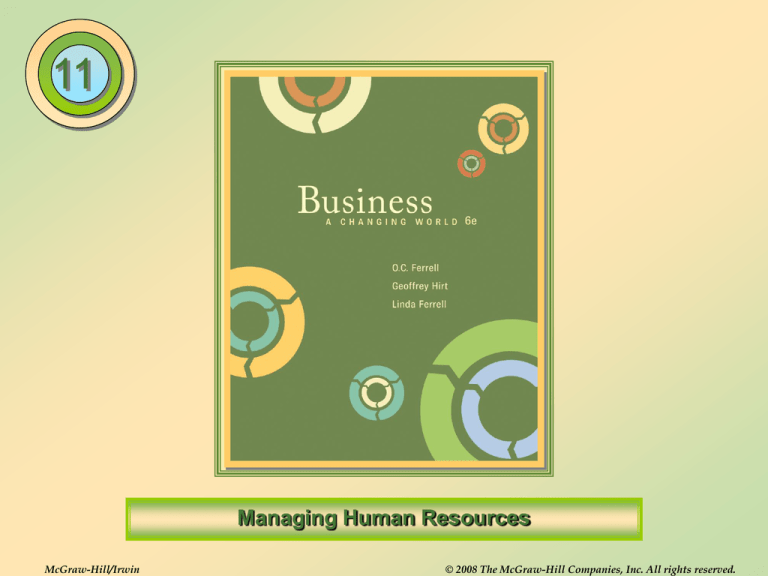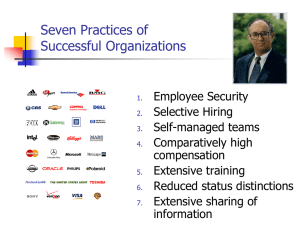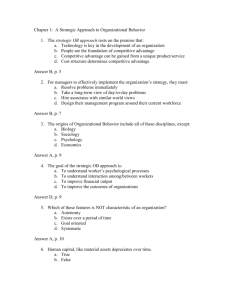
11
Managing Human Resources
McGraw-Hill/Irwin
© 2008 The McGraw-Hill Companies, Inc. All rights reserved.
11-2
The Nature of Human
Resources Management (HRM)
• HRM:
– All activities involved in determining an
organization’s human resource needs, as well as
acquiring, training, and compensating people to fill
those needs
11-3
Planning for Human Resources
Needs
• Typical HR Issues:
– How many employees?
– What skills are needed to satisfy plans?
– Availability of people in the workforce?
– What qualifications must employees have?
– Cost of staffing?
11-4
Processes of Job Analysis
• Job Analysis:
– The determination through observation and study, of
pertinent information about a job, including specific
tasks and necessary abilities, knowledge, and skills
• Job Description:
– The formal, written description of a specific job, such
as the job title, tasks to be performed, physical and
mental skills required, duties, and responsibilities
• Job Specification:
– The written description of the qualifications necessary
for a specific job, such as education, experience,
personal characteristics, and physical characteristics
11-5
Recruiting New Employees
• Internal
– The organization’s current employees
• External
– Advertisements in newspapers and professional
journals
– Employment agencies
– Colleges, vocational schools
– Recommendations from current employees
– Competing firms
– Unsolicited applications
Did You Know?
Several years ago, 21% of companies
– Online
said they recruited online. Experts say
it over 80% today.
11-6
The Selection Process
JOB
Reference Checking
Testing
Interview
Application
11-7
Interviewing Tips
11-8
Top 10 Interview Questions
11-9
Myers-Briggs Type Indicator
Categories
Source: Christopher Caggiano, “Psycho Path,” Inc., July 1998, p. 81. Reprinted with permission of
Inc. Magazine, Goldhirsh Group, Inc. Reproduced by permission of the publisher via Copyright
Clearance Center, Inc.
11-10
Legal Issues in Recruiting
and Selecting New Employees
• Fair Labor Standards Act (1938)
– Sets minimum wages and overtime rates (for any time over 40
hours per week).
• Equal Pay Act (1963)
– Requires that men and women who do equal work be paid
equally.
• Title VII of the Civil rights Act (1964)
– Created the Equal Employment Opportunity Commission
– Mandates affirmative action programs
– Outlaws discrimination on the basis of sex, race, color, or
national origin
Did You Know?
40+ years after the Civil Rights Act was passed,
corporate officers are only 8.2% African
American,5% Hispanic, and 12.5% women.
11-11
Legislation Regulating Hiring and
Compensation Practices
• Age Discrimination in Employment Act
(1967)
– Outlaws employment practices that
discriminate on the basis of age
• Americans with Disabilities Act
– Prevents discrimination against disabled
persons
Source: Annie Finnigan, “Different Strokes,” Working Woman, April 2001, p. 42.
11-12
Affirmative Action
• Legally mandated plans that try to
increase job opportunities for minority
groups by:
– Analyzing the current pool of workers
– Identifying areas where women and minorities
are underrepresented
– Establishing specific hiring and promotion
goals, with target dates, for addressing
discrepancy
11-13
Developing the Workforce
•
Employee orientation
–
•
Employee training and development
–
–
•
Familiarizes the newly hired employees with
fellow workers, company procedures, and the
physical properties of the company.
On-the-job
Classroom
Assessing employee performance
–
Performance appraisals
Did You Know?
Internet-based training is expected to grow
to be a $14.5 billion market by 2004.
11-14
Employee Turnover
• Promotion
• Transfer
• Separation
–
–
–
–
Resignation
Retirement
Termination
Layoffs
11-15
Compensating the Work Force
• Time Wages
– Financial award based on number of hours
worked
• Piece Wages
– Financial award based on the output attained
by the employee
• Commission
– Payment to an employee of a fixed amount or
a percentage of the employee’s sales
11-16
Compensating the Workforce
• Salary
– Financial award calculated on a weekly, monthly, or
annual basis
• Bonus
– An addition to regular compensation for exceptional
performance or in appreciation for good work
• Profit sharing
– Distribution of percentage of company profit to
employees; sometimes distribution is in the form of
company stock
11-17
Hourly Wages: U.S. vs. India
U.S.
Occupation
India
$12.57
$13.17
Telephone Operator
Medical (Health Record)
Technologists/Transcriptionists
Under $1.00
$1.50-2.00
$15.17
$17.86
$23.35
$33.00-35.00
Payroll Clerk
Legal Assistant/Paralegal
Accountant
Financial Researcher/Analyst
$1.50-2.00
$6.00-8.00
$6.00-15.00
$6.00-15.00
Matthew Grimm (2004) “Profits vs. Jobs”. American Demographics, June 1,
www.demographics.com.microsites.magazineartcle.asp? …accessed August 2, 2004.
11-18
Retention Methods
Source: Kemba J. Dunham, “The Jungle,” The Wall Street Journal, May 15, 2001, p. B12. Copyright ©
2001 by Dow Jones & Co., Inc. Reprinted with permission of Dow Jones & Co., Inc. via Copyright
Clearance Center. 60% Flexible hours and schedules 53% Mentoring programs 25% Profit-sharing
22%
11-19
Benefits
• Non-financial forms of compensation
provided to employees such as:
–
–
–
–
–
–
–
–
Pension plans for retirement
Health, disability, and life insurance
Holidays and paid days off for vacation or illness
Credit union membership
Health programs
Child care
Elder care
Assistance with adoption
11-20
Increasing Employee
Satisfaction
American Workers Prefer Happiness Over
Money
What American’s Value Most About Work:
Job Satisfaction
65%
Being Paid Well
34%
Having an Important Title
1%
Source: USA Today Snapshots, September 20, 2001, D-1.
11-21
Increasing Employee
Satisfaction
Benefits:
Child care assistance
% Offering
91
Elder care programs
Flexible schedules
Adoption benefits
49
73
32
Personal/professional growth
Financial security programs
Group/discounted purchases
78
41
39
On-site personal services
Casual dress
57
66
Source: “Hewitt Study Shows Work/Life Benefits Continue to Grow Despite Slowing Economy,” Hewitt
Associates LLC press release, April 23, 2001.
11-22
Managing Unionized Employees
• Labor Unions:
– Employee organizations formed to deal with
employers to achieve better pay, hours, and
working conditions
11-23
Managing Unionized Labor
• Collective Bargaining:
– The negotiation process through which
management and unions reach agreement
about compensation, working hours, and
working conditions for a bargaining unit
• Labor Contract:
– The formal, written document that spells out
the relationship between the union and
management for a specified period of time –
usually two or three years
11-24
The Collective Bargaining
Process
11-25
Resolving Disputes
• Labor’s Tactics
– Strikes
– Picketing
– Boycott
• Management’s
Tactics
– Lockout
– Strikebreakers/hiring
replacements
11-26
Outside Resolution
• Conciliation
– The conciliator’s goal is to get both parties to focus on
the issues and to prevent negotiations from breaking
down.
• Mediation
– The mediator’s role is to suggest or propose a
solution to the problem.
• Arbitration
– The arbitrator’s solution is legally binding and
enforceable.
11-27
Workforce Diversity
• Understanding diversity means
recognizing and accepting differences as
well as valuing the unique perspectives
such differences can bring to the
workplace.
11-28
Characteristics of Diversity
Source: Marilyn Loden and Judy B. Rosener, Workforce America! Managing Employee Diversity as a Vital Resource,
1991, p. 20. Used with permission. Copyright © 1991 Richard D. Irwin, a Times Mirror Higher Education Group, Inc.,
company.
11-29
U.S. Census Bureau People
Quick Facts
11-30
The Benefits of
Workforce Diversity
1. More productive use of a company’s human
resources
2. Reduced conflict among employees of different
backgrounds as they learn to respect each other’s
differences
3. More productive working relationships
4. Increased commitment to and sharing of
organizational goals among diverse employees at
all organizational levels
5. Increased innovation and creativity
6. Increased ability to serve the needs of an
increasingly diverse customer base
11-31
America’s 20 Best Companies
for Minorities
11-32
Affirmative Action Programs
• Legally mandated plans that try to increase job
opportunities for minority groups by:
– Analyzing the current pool of workers
– Identifying areas where women and minorities are
underrepresented
– Establishing specific hiring and promotion goals to
resolve the discrepancy.
• Prohibits organizations from setting hiring
quotas that might result in reverse
discrimination.
11-33
Median Annual Income for Some
HR Jobs
Labor relations manager
$107,900
Compensation manager
$97,800
Human resources manager
$91,400
Benefits manager
$85,500
Training manager
$78,200
Payroll manager
$70,800
43.“Human Resources Managers,” CareerJournal (n.d.),
www.careerjournal.com/salaryhiring/industries/hr/20040127- hr-tab.html (accessed May 7, 2004);“Median
Annual Income, by Level of Education, 1990–2000, InfoPlease (n.d.), www.infoplease.com/ipa/A0883617.htm
(accessed May 7, 2004).
11-34
Solve the Dilemma
1. What did Medallion’s HRM department do right
in dealing with the employees who were laid
off?
2. What are some of the potential problems that
must be dealt with after an organization
experiences a major trauma such as massive
layoffs?
3. What can Medallion do to make the team
approach work more smoothly? What role do
you think diversity training should play?
11-35
Explore Your Career Options
• What are some of the factors
you consider most important
in deciding which job to
accept after graduation?
– Is your decision about your
college major most influenced
by salary, hiring potential in
particular areas, or quality of life
issues?
11-36
Additional Discussion Questions
and Exercises
1. Where do most firms recruit qualified applicants?
2. Why has the use of physical examinations in the
selection process become controversial for business?
3. Employee Assistance Programs (EAPs) add to
company costs.
– Why should a firm bother with EAPs ?
4. Bring a copy of a local newspaper “Help Wanted”
section to class.
– What qualifications (job specifications) do the ads request of
applicants?
11-37
Additional Discussion Questions
and Exercises
5. Bring a copy of a performance appraisal form
to class. Copies may be secured from
companies or examples may be presented in
textbooks.
–
–
Is the performance appraisal based on objective or
subjective information?
Is the performance appraisal based on preset
objectives for the individual employee?
11-38
Chapter 11 Quiz
1. Which of the following positions is most likely to be
compensated through commissions?
a.
b.
c.
d.
Counter worker at a fast-food restaurant
Bricklayer
Automobile salesperson
Secretary
2. Which of the following is not an example of a benefit?
a.
b.
c.
d.
Bonuses
Retirement plans
Health insurance
Credit union membership
11-39
Chapter 11 Quiz
3.
Which of the following brings in a neutral third party to
settle the dispute in which the decision made by the
third party is legally binding and enforceable?
a.
b.
c.
d.
4.
Boycott
Conciliation
Mediation
arbitration
Which of the following is NOT a benefit of work-force
diversity?
a.
b.
c.
d.
more productive use of company's human resources
reduced conflict among employees of different ethnicities
increased conflict among employees of different ethnicities
increased innovation and creativity
11-40
Multiple Choice Questions
about the Video
1. Which of the following is NOT something that the bully
broads program offers?
a.
b.
c.
d.
One on one coaching
Group therapy
Role playing
Counseling
2. Which of the following is a reason why women attend
these programs?
a.
b.
c.
d.
It makes them feel more powerful
They learn to be less polite
Because co-workers are intimidated by them
Because they feel vulnerable
11-41




